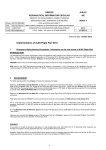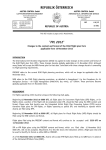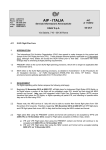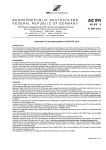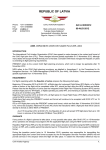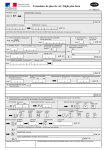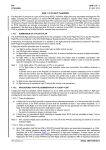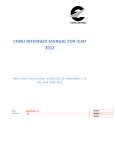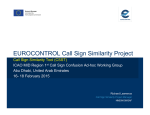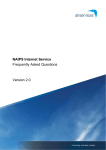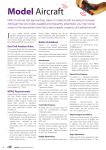Download united kingdom aeronautical information circular
Transcript
UNITED KINGDOM AERONAUTICAL INFORMATION NATS Ltd CIRCULAR UK Aeronautical Information Service Heathrow House Bath Road Hounslow, Middlesex TW5 9AT Email: [email protected] URL: http://www.ais.org.uk Phone: 020-7453 6553 (Content - DAP/CAS) Phone: 0191-203 2329 (Distribution - Communisis UK) AIC: Y 099/2012 14-JUN-2012 Operational CHANGES TO FLIGHT PLANNING PROCEDURES. 1 Introduction 1.1 The ICAO Air Traffic Management Requirements and Performance Panel (ATMRPP) has developed a concept for a flight planning system to support future operations in accordance with the Global ATM Concept. Current flight planning provisions have not been addressed for many years and no longer accurately reflect advances that have been made in both airborne and ground-based systems. The concept that has been developed defines information requirements for flight planning, flow management and trajectory management and aims to facilitate the best possible integrated past, present and future ATM situation. This exchange of information will enable improved decision making by the ATM actors involved in the entire duration of a flight, i.e. gate-to-gate, thus facilitating 4-D trajectory operations. 1.2 Work is ongoing to develop the necessary standards and documentation, including implementation and transition guidance, to allow elements of the concept to be introduced as early as possible ahead of full implementation of the Collaborative Environment envisaged by the Global ATM Concept and the programme of Aviation System Block Upgrades initiated by ICAO, of which the future flight planning process is a part. As an interim step, ICAO has published an amendment to the Procedures for Air Navigation Services - Air Traffic Management (PANS-ATM, Doc 4444) 15th Edition. This amendment allows the flight plan to accurately reflect the equipment on board the aircraft and the capabilities of both it and the crew and also changes the way certain other information elements are presented in the flight plan. These changes become globally applicable on 15 November 2012. It is important that implementation of this amendment is achieved in a coordinated and timely manner and the European region aims to be fully compliant by this date. 1.3 The aim of this AIC is to publicise the UK requirements resulting from the amendment to PANS-ATM. Throughout this AIC PRESENT refers to the current ICAO flight planning provisions, which will no longer be applicable after 15 November, and NEW refers to the provisions introduced by the amendment to PANS-ATM. Full details of the amendment can be found in the Appendices to this AIC. 2 Requirement 2.1 For flights operating within United Kingdom airspace the following shall apply: a. Beginning 12 November 2012 at 0000 UTC, all flight plans for Instrument Flight Rules (IFR) flights, or for flights where a portion of the flight will be completed under IFR, should be filed using the NEW content although those filed using PRESENT will continue to be accepted. As the United Kingdom uses the Integrated Initial Flight Plan Processing System (IFPS) service all flight plans for IFR flights, or flights operating as partial IFR, that originate in countries within the IFPS Zone are to be filed using IFPS; b. Beginning 12 November 2012 at 0000 UTC, all flight plans for Visual Flight Rules (VFR) flights should be filed using the NEW content; c. Flight plans filed using the PRESENT content will continue to be accepted until 0000 UTC on 15 November 2012. IFR or VFR flight plans using the PRESENT content and format, which are filed after 0000 UTC on 15 November 2012 will not be accepted. Only flight plans using the NEW format will be accepted after this time. Appendix A to this AIC shows the indications within a flight plan that will be used to identify its format as either NEW or PRESENT. 2.2 From 0000 UTC on 15 November 2012 the United Kingdom will accept VFR flight plans filed up to 120 hours in advance of the Estimated Off-Block Time (EOBT). If the flight plan is filed more than 24 hours in advance of EOBT the Date of Flight (DOF) must be included in Field 18 of the flight plan. 3 Guidance 3.1 If any portion of a flight is planned to take place, or may possibly take place, after 0000 UTC on 15 November 2012, operators are strongly encouraged to file the applicable flight plan using the NEW content. 3.2 Repetitive Flight Plans (RPLs) for the 2012/2013 winter season should be submitted using the NEW content. An RPL with a validity period that extends beyond 15 November 2012 will not be accepted in PRESENT format. 1. 3.3 During the transition period (prior to 15 November 2012) operators are responsible for transmitting the appropriate flight plan content accepted by the Air Navigation Services Providers (ANSPs) that will provide services in the airspace where the flight will take place. To obtain this information reference may be made to the ICAO Flight Plan Implementation Tracking System (FITS) website: (http://www2.icao.int/en/FITS/Pages/home.aspx). The applicable Aeronautical Information Publications (AIP) should be consulted for the official notifications provided by States. 3.4 Operators are encouraged to use the IFPS Validation (IFPUV) Application (see Appendix B), provided by EUROCONTROL, to test the validity of their flight plans well in advance of 15 November 2012. 3.5 The United Kingdom is within the IFPS area. All flight plans for IFR flights, or where a portion of the flight will be carried out under IFR, are to be submitted to IFPS. The following schedule is applicable to the IFPS transition from PRESENT to NEW flight plans: a. IFPS accepts today IFR flight plans (or portions thereof) filed using both PRESENT and NEW content. Prior to 15 November 2012 IFPS will translate flight plans filed using NEW content back into PRESENT for onward transmission to ANSPs until they are ready to accept the NEW content; b. From 0000 UTC on 15 November 2012 IFPS will only accept flight plans filed using the NEW content; c. Flights with a date of flight between 12 and 16 November 2012 cannot be submitted more than 24 hours in advance of the Estimated Off Block Time (EOBT). As of 0000 UTC on 16 November 2012 IFPS will resume accepting flight plans filed more than 24 hours in advance of the EOBT. Flight plans filed more than 120 hours in advance of the EOBT will not be accepted. 3.6 Operators are reminded that IFPS cannot be used to submit flight plans operated entirely as VFR to or from the United Kingdom. 3.7 Reference should be made to the IFPS User Manual for all details concerning IFPS operational procedures and processes. The Manual is available via the CFMU web site under 'Library' (www.cfmu.eurocontrol.int/cfmu/public/standard_page/library_index.html). 3.8 Operators are encouraged always to include the Date of Flight (DOF) in Item 18 of the flight plan. It is mandatory to include DOF if the flight plan is filed more than 24 hours in advance of the EOBT. 3.9 Operators should note the changed intention of Item 10 of the FPL. Under the NEW provisions, Item 10 indicates equipment and capabilities. Capability is comprised of three elements: a. presence of relevant serviceable equipment on board the aircraft; b. equipment and capabilities commensurate with flight crew qualification; and c. where applicable, authorization from the appropriate authority. 3.10 Appendix C to this Aeronautical Information Circular describes the changes to the ICAO FPL content in detail. The amendment to the ICAO flight planning provisions is available on the ICAO European and North Atlantic website (www.paris.icao.int) by following the links to ‘Other Meetings, Seminars & Workshops’, then to ‘FPL 2012 ICAO EUR Region Plan’ and then to ‘Documentation related to FPL 2012 Amendment’. All documentation related to the IFPS implementation of these changes is available on the EUROCONTROL CFMU website (www.cfmu.eurocontrol.int) by following the link to ‘ICAO 2012 FPL’. 4 Testing 4.1 The CFMU has published the EUR 2012 Test Plan Document which describes the testing activities that will be hosted by them to support the introduction of the amended flight planning provisions. The document includes descriptions of static testing, test schedules and registration forms to take part in the operational testing. There are two remaining operational test sessions planned: a. OPT 5: 3-7 September 2012; b. OPT 6: 24-28 September 2012. 4.2 All stakeholders who file flight plans are strongly encouraged to participate in these testing activities as robust testing is seen as essential to ensure a successful transition to the NEW flight planning provisions. Stakeholders should ensure that the suppliers of their Flight Data Processing Systems and/or Computerised Flight Planning Systems have carried out the necessary software changes to facilitate the use of the NEW flight planning provisions. 5 Additional Information 5.1 Further information can be obtained from: Controlled Airspace Section Directorate of Airspace Policy CAA House, K6 45-59 Kingsway London WC2B 6TE Phone: 020-7453-6553 Email: [email protected] 2. Appendix A - Indications of NEW and PRESENT formats A flight plan is deemed to be PRESENT format if it contains any of the following indications: a. In Field 10a: J, M; b. In Field 10b: D; c. In STS/: ATFMEXEMPTAPPROVED, free text i.e. any indication other than those specified; d. In PER/: Indications other than A, B, C, D, E, H. A flight plan is deemed to be NEW format if it contains any of the following indications: a. In Field 10a: E1, E2, E3, J1, J2, J3, J4, J5, J6, J7, M1, M2, M3, P1, P2, P3, P4, P5, P6, P7, P8, P9; b. In Field 10b: E, H, L, B1, B2, U1, U2, V1, V2, D1, G1; c. In Item 18: PBN/, SUR/, DLE/, TALT/, EUR/PROTECTED; Note: EUR/PROTECTED is to be used only within the IFPS Zone d. In STS/: ATFMX; e. In DAT/: characters other than S, H, V, M; f. A CHG, CNL, DLA, DEP messages containing Field 18 with more than just DOF/. If a flight plan contains none of the indications above it qualifies as both NEW and PRESENT and will be treated accordingly. 3. Appendix B - IFPS Validation System The IFPUV Application will detect whether a test flight plan contains NEW content and format and will highlight any syntax errors which are detected. It is important to note that the IFPUV Application can be used to syntax check any flight plan, whether or not any portion of the route is within the IFPS Zone (IFPZ). The IFPUV Application can also be used to syntax check flight plans for VFR flights. The IFPUV Application will first check the syntax of the flight plan, and then will check whether the flight plan is entirely VFR and whether any portion of the route is within the IFPS. If the entire flight plan is VFR or if no part of the route is within the IFPZ, the following error message will be sent in return: ROUTE 152: FLIGHT NOT APPLICABLE TO IFPS If this is the only error message sent in return, the IFPUV Application has not detected any syntax errors. If a syntax error is detected, the specific flight plan Item or Items will be highlighted and a description of the error or errors will be provided. The IFPUV Application is available on the EUROCONTROL Central Flow Management Unit (CFMU) website (www.cfmu.eurocontrol.int), via the link to ‘CFMU NOP - Public’. After ensuring that the ‘TACTICAL’ tab is selected, users should select the ‘IFPUV - Flight Planning’ link. Test flight plans can be checked, as described above, using the IFPUV - Free Text Editor. Test flight plans are input and submitted one at a time. 4. Appendix C - Detailed description of changes to ICAO FPL content The ICAO provisions have been amended to specify that flight plans may not be filed more than 120 hours in advance of the EOBT. When it is necessary to delay a flight over the midnight period, thereby changing the DOF, the UK will continue to use the DLA message indicating the modification to the EOBT. If it is necessary to modify a field in the flight plan the data for the complete field must be provided and not just the modified elements, this is particularly significant for modifications to Field 18. Air Traffic Services (ATS) data systems may impose constraints on information in flight plans. Significant constraints are to be notified in Aeronautical Information Publications (AIP). The changes made to specific FPL Items are as follows: Item 7 - Aircraft Identification: The explanation of this provision has been clarified to specify that the aircraft identification cannot exceed 7 alphanumeric characters and is not to include hyphens or symbols. No other changes have been made to the provision. Item 8 - Flight Rules and Type of Flight: The explanation of the provision related to indicating flight rules has been clarified. It has also been clarified that it must be specified in Item 15 (Route) the point or points at which a change in flight rules is planned. Additional text has been added to highlight that the status of the flight is to be denoted in Item 18 following the STS indicator, using one of the defined descriptors, or that other reasons for specific handling by ATS are to be denoted in Item 18 following the RMK indicator. No other changes have been made to the provision. Item 10 - Equipment and Capabilities: Numerous changes have been made to this provision. It is important to note that Item 10 now also indicates capabilities, which consists of three elements: presence of relevant serviceable equipment on board the aircraft; equipment and capabilities commensurate with crew qualifications; and, where applicable, authorization from the appropriate authority. The following provisions are applicable to Item 10a (Radio communication, navigation and approach aid equipment and capabilities): INSERT one letter as follows: N if no COM/NAV/approach aid equipment for the route to be flown is carried, or the equipment is unserviceable, OR S if standard COM/NAV/approach aid equipment for the route to be flown is carried and serviceable (see Note 1), AND/OR INSERT one or more of the following letters to indicate the serviceable COM/NAV/approach aid equipment and capabilities available: A GBAS landing system J7 CPDLC FANS 1/A SATCOM (Iridium) B LPV (APV with SBAS) K MLS C LORAN C L ILS D DME M1 ATC RTF SATCOM (INMARSAT) E1 FMC WPR ACARS M2 ATC RTF (MTSAT) E2 D-FIS ACARS M3 ATC RTF (Iridium) E3 PDC ACARS O1 VOR F ADF P1-P9 Reserved for RCP G GNSS (See Note 2) R PBN approved (see Note 4) H HF RTF T TACAN I Inertial Navigation U UHF RTF J1 CPDLC ATN VDL Mode 2 (See Note 3) V VHF RTF J2 CPDLC FANS 1/A HFDL W RVSM approved J3 CPDLC FANS 1/A VDL Mode 4 X MNPS approved J4 CPDLC FANS 1/A VDL Mode 2 Y VHF with 8.33 kHz channel spacing capability J5 CPDLC FANS 1/A SATCOM (INMARSAT) Z Other equipment carried or other capabilities (see Note 5) J6 CPDLC FANS 1/A SATCOM (MTSAT) Any alphanumeric characters not indicated above are reserved. Note 1: If the letter S is used, standard equipment is considered to be VHF RTF, VOR and ILS, unless another combination is prescribed by the appropriate ATS authority. Note 2: If the letter G is used, the types of external GNSS augmentation, if any, are specified in Item 18 following the indicator NAV/ separated by a space. and 5. Note 3: See RTCA/EUROCAE Interoperability Requirements Standard For ATN Baseline 1 (ATN B1 INTEROP Standard - DO-280B/ED110B) for data link services air traffic control clearance and information/air traffic control communications management/air traffic control microphone check. Note 4: If the letter R is used, the performance based navigation levels that can be met are specified in Item 18 following the indicator PBN/. Guidance material on the application of performance based navigation to a specific route segment, route or area is contained in the Performance-Based Navigation Manual (Doc 9613). Note 5: If the letter Z is used, specify in Item 18 the other equipment carried or other capabilities, preceded by COM/, NAV/ and/or DAT, as appropriate. In the EUR Region exemptions for RNAV, CPDLC and 8.33 kHz are to indicated by inserting the letter Z in Item 10a and then inserting the following indicators as appropriate in Item 18, as detailed in the IFPS Users Manual and Section ENR 1-10 of the UK AIP: a. Insert EXM833 following COM/; b. Insert RNAVX or RNAVINOP as appropriate following NAV/; c. Insert CPDLX following DAT/. Note 6: Information on navigation capability is provided to ATC for clearance and routing purposes. The following provisions are applicable to Item 10b (Surveillance equipment and capabilities): INSERT N if no surveillance equipment for the route to be flown is carried, or the equipment is unserviceable, OR INSERT one or more of the following descriptors, to a maximum of 20 characters, to describe the serviceable surveillance equipment and/or capabilities on board: SSR Modes A and C A Transponder - Mode A (4 digits - 4 096 codes) C Transponder - Mode A (4 digits - 4 096 codes) and Mode C SSR Mode S E Transponder - Mode S, including aircraft identification, pressure-altitude and extended squitter (ADS-B) capability H Transponder - Mode S, including aircraft identification, pressure-altitude and enhanced surveillance capability I Transponder - Mode S, including aircraft identification, but no pressure-altitude capability L Transponder - Mode S, including aircraft identification, pressure-altitude, extended squitter (ADS-B) and enhanced surveillance capability P Transponder - Mode S, including pressure-altitude, but no aircraft identification capability S Transponder - Mode S, including both pressure altitude and aircraft identification capability X Transponder - Mode S with neither aircraft identification nor pressure-altitude capability Note: Enhanced surveillance capability is the ability of the aircraft to down-link aircraft derived data via a Mode S transponder. ADS-B B1 ADS-B with dedicated 1090 MHz ADS-B ‘out’ capability B2 ADS-B with dedicated 1090 MHz ADS-B ‘out’ and ‘in’ capability U1 ADS-B ‘out’ capability using UAT U2 ADS-B ‘out’ and ‘in’ capability using UAT V1 ADS-B ‘out’ capability using VDL Mode 4 V2 ADS-B ‘out’ and ‘in’ capability using VDL Mode 4 ADS-C D1 ADS-C with FANS 1/A capabilities G1 ADS-C with ATN capabilities Any alphanumeric characters not indicated above are reserved. Example: ADE3RV/HB2U2V2G1 Note: Additional surveillance application should be listed in Item 18 following the indicator SUR/. Item 13 - Departure aerodrome and time: Some clarifications have been made and additional provisions included regarding how to indicate departure aerodromes which have not been assigned an ICAO four-letter designator. The following provisions are applicable to Item 13: INSERT the ICAO four-letter location indicator of the departure aerodrome as specified in Doc 7910, Location Indicators, OR, if no location indicator has been assigned, INSERT ZZZZ and SPECIFY, in Item 18, the name and location of the aerodrome preceded by DEP/, OR, 6. the first point of the route or the marker radio beacon preceded by DEP/…, if the aircraft has not taken off from the aerodrome, OR, if the flight plan is received from an aircraft in flight, INSERT AFIL, and SPECIFY, in Item 18, the ICAO four-letter location indicator of the location of the ATS unit from which supplementary flight plan data can be obtained, preceded by DEP/. THEN, WITHOUT A SPACE, INSERT for a flight plan submitted before departure, the estimated off-block time (EOBT), OR, for a flight plan received from an aircraft in flight, the actual or estimated time over the first point of the route to which the flight plan applies. Item 15c - Route (including changes of speed, level and/or flight rules): an editorial change has been made to clarify that it is possible to indicate, at a single point, where it is planned that a change of speed or level or both is planned to commence, or a change of ATS route and/or a change of flight rules. The provision has been expanded to include the possibility of describing a significant point in the route as a bearing or distance from a ‘reference point’, rather than only from a navigational aid, as follows: Bearing and distance from a reference point: The identification of the reference point, followed by the bearing from the point in the form of 3 figures giving degrees magnetic, followed by the distance from the point in the form of 3 figures expressing nautical miles. In areas of high latitude where it is determined by the appropriate authority that reference to degrees magnetic is impractical, degrees true may be used. Make up the correct number of figures, where necessary, by insertion of zeros - e.g. a point 180° magnetic at a distance of 40 nautical miles from VOR’DUB’ should be expressed as DUB180040. Item 16 - The title of Item 16 has been clarified to specify that the ‘alternate aerodrome(s)’ being referred to is(are) the destination alternate aerodrome(s). Additionally, the provision related to estimated elapsed time has been clarified, along with the descriptions of how to indicate the locations, as follows: Destination aerodrome and total estimated elapsed time (8 characters) INSERT the ICAO four-letter location indicator of the destination aerodrome as specified in Doc 7910, Location Indicators, OR ,if no location indicator has been assigned, INSERT ZZZZ and SPECIFY in Item 18 the name and location of the aerodrome, preceded by DEST/. THEN WITHOUT A SPACE INSERT the total estimated elapsed time. Note: For a flight plan received from an aircraft in flight, the total estimated elapsed time is the estimated time from the first point of the route to which the flight plan applies to the termination point of the flight plan. Destination alternate aerodrome(s) INSERT the ICAO four-letter location indicator(s) of not more than two destination alternate aerodromes, as specified in Doc 7910, Location Indicators, separated by a space, OR, if no location indicator has been assigned to the destination alternate aerodrome(s), INSERT ZZZZ and SPECIFY in Item 18 the name and location of the destination alternate aerodrome(s), preceded by ALTN/. Item 18 - Other Information: Significant changes have been made to these provisions. Operators are warned that the use of indicators not included in the provisions may result in data being rejected, processed incorrectly or lost. The provision has been clarified to indicate that hyphens ‘-’ or oblique strokes ‘/’ should only be used as described. The provision has been amended such that only indicators described in the provisions may be used, and they must be inserted in the order shown. The indicators defined are as follows, and are listed in the order in which they are to be inserted, if used: STS/ Reason for special handling by ATS, e.g. a search and rescue mission, as follows: ALTRV: for a flight operated in accordance with an altitude reservation; ATFMX: for a flight approved for exemption from ATFM measures by the appropriate ATS authority; FFR: fire-fighting; FLTCK: flight check for calibration of navaids; HAZMAT: for a flight carrying hazardous material; HEAD: a flight with Head of State status; HOSP: for a medical flight declared by medical authorities; 7. HUM: for a flight operating on a humanitarian mission; MARSA: for a flight for which a military entity assumes responsibility for separation of military aircraft; MEDEVAC: for a life critical medical emergency evacuation; NONRVSM: for a non-RVSM capable flight intending to operate in RVSM airspace; SAR: for a flight engaged in a search and rescue mission; and STATE: for a flight engaged in military, customs or police services. Other reasons for special handling by ATS shall be denoted under the designator RMK/. PBN/ Indication of RNAV and/or RNP capabilities. Include as many of the descriptors below, as apply to the flight, up to a maximum of 8 entries, i.e. a total of not more than 16 characters. RNAV SPECIFICATIONS A1 RNAV 10 (RNP 10) B1 RNAV 5 all permitted sensors B2 RNAV 5 GNSS B3 RNAV 5 DME/DME B4 RNAV 5 VOR/DME B5 RNAV 5 INS or IRS B6 RNAV 5 LORANC C1 RNAV 2 all permitted sensors C2 RNAV 2 GNSS C3 RNAV 2 DME/DME C4 RNAV 2 DME/DME/IRU D1 RNAV 1 all permitted sensors D2 RNAV 1 GNSS D3 RNAV 1 DME/DME D4 RNAV 1 DME/DME/IRU RNP SPECIFICATIONS L1 RNP 4 O1 Basic RNP 1 all permitted sensors O2 Basic RNP 1 GNSS O3 Basic RNP 1 DME/DME O4 Basic RNP 1 DME/DME/IRU S1 RNP APCH S2 RNP APCH with BARO-VNAV T1 RNP AR APCH with RF (special authorization required) T2 RNP AR APCH without RF (special authorization required) Combinations of alphanumeric characters not indicated above are reserved. 8. NAV/ Significant data related to navigation equipment, other than specified in PBN/, as required by the appropriate ATS authority. Indicate GNSS augmentation under this indicator, with a space between two or more methods of augmentation, e.g. NAV/GBAS SBAS. If appropriate, insert RNAVX or RNAVINOP (i.e. if Z has been included in Item 10a as described above) as detailed in the IFPS User Manual and Section ENR 1-10 of the UK AIP. COM/ Indicate communications applications or capabilities not specified in Item 10a. If appropriate, insert EXM833 (if 'Z' has been included in Item 10a) as detailed in the IFPS User Manual and Section ENR 1-10 of the UK AIP. DAT/ Indicate data applications or capabilities not specified in 10a. If appropriate, insert CPDLCX (if 'Z' has been included in Item 10a) as detailed in the IFPS User Manual and Section ENR 1-10 of the UK AIP. SUR/ Include surveillance applications or capabilities not specified in Item 10b. DEP/ Name and location of departure aerodrome, if ZZZZ is inserted in Item 13, or the ATS unit from which supplementary flight plan data can be obtained, if AFIL is inserted in Item 13. For aerodromes not listed in the relevant Aeronautical Information Publication, indicate location as follows: With 4 figures describing latitude in degrees and tens and units of minutes followed by ‘N’ (North) or ‘S’ (South), followed by 5 figures describing longitude in degrees and tens and units of minutes, followed by ‘E’ (East) or ‘W’ (West). Make up the correct number of figures, where necessary, by insertion of zeros, e.g. 4620N07805W (11 characters). OR, Bearing and distance from the nearest significant point, as follows: The identification of the significant point followed by the bearing from the point in the form of 3 figures giving degrees magnetic, followed by the distance from the point in the form of 3 figures expressing nautical miles. In areas of high latitude where it is determined by the appropriate authority that reference to degrees magnetic is impractical, degrees true may be used. Make up the correct number of figures, where necessary, by insertion of zeros, e.g. a point of 180° magnetic at a distance of 40 nautical miles from VOR ‘DUB’ should be expressed as DUB180040. OR, The first point of the route (name or LAT/LONG) or the marker radio beacon, if the aircraft has not taken off from an aerodrome. DEST/ Name and location of destination aerodrome, if ZZZZ is inserted in Item 16. For aerodromes not listed in the relevant Aeronautical Information Publication, indicate location in LAT/LONG or bearing and distance from the nearest significant point, as described under DEP/ above. DOF/ The date of flight departure in a six figure format (YYMMDD, where YY equals the year, MM equals the month and DD equals the day). REG/ The nationality or common mark and registration mark of the aircraft, if different from the aircraft identification in Item 7. EET/ Significant points or FIR boundary designators and accumulated estimated elapsed times from take-off to such points or FIR boundaries, when so prescribed on the basis of regional air navigation agreements, or by the appropriate ATS authority. Examples: EET/CAP0745 XYZ0830 EET/EINN0204 SEL/ SELCAL Code, for aircraft so equipped. TYP/ Type(s) of aircraft, preceded if necessary without a space by number(s) of aircraft and separated by one space, if ZZZZ is inserted in Item 9. Example: TYP/2F15 5F5 3B2 CODE/ Aircraft address (expressed in the form of an alphanumerical code of six hexadecimal characters) when required by the appropriate ATS authority. Example: ‘F00001’ is the lowest aircraft address contained in the specific block administered by ICAO. RVR/ The minimum RVR requirement of the flight. Note: This provision is detailed in the European Regional Supplementary Procedures (EUR SUPPs, Doc 7030), Chapter 2. DLE/ En-route delay or holding, insert the significant point(s) on the route where a delay is planned to occur, followed by the length of delay using four figure time in hours and minutes (hhmm). Example: OPR/ DLE/MDG0030 ICAO designator or name of the aircraft operating agency, if different from the aircraft identification in item 7. ORGN/ The originator's 8 letter AFTN address or other appropriate contact details, in cases where the originator of the flight plan may not be readily identified, as required by the appropriate ATS authority. Note.- In some areas, flight plan reception centres may insert the ORGN/ identifier and originator's AFTN address automatically PER/ Aircraft performance data, indicated by a single letter as specified in the Procedures for Air Navigation Services - Aircraft Operations (PANS-OPS, Doc 8168), Volume I - Flight Procedures, if so prescribed by the appropriate ATS authority. ALTN/ Name of destination alternate aerodrome(s), if ZZZZ is inserted in Item 16. For aerodromes not listed in the relevant Aeronautical Information Publication, indicate location in LAT/LONG or bearing and distance from the nearest significant point, as described in DEP/ above. RALT/ ICAO four letter indicator(s) for en-route alternate(s), as specified in Doc 7910, Location Indicators, or name(s) of en-route alternate aerodrome(s), if no indicator is allocated. For aerodromes not listed in the relevant Aeronautical Information Publication, indicate location in LAT/LONG or bearing and distance from the nearest significant point, as described in DEP/ above. TALT/ ICAO four letter indicator(s) for take-off alternate, as specified in Doc 7910, Location Indicators, or name of take-off alternate aerodrome, if no indicator is allocated. For aerodromes not listed in the relevant Aeronautical Information Publication, indicate location in LAT/LONG or bearing and distance from the nearest significant point, as described in DEP/ above. 9. RIF/ The route details to the revised destination aerodrome, following by the ICAO four-letter location indicator of the aerodrome. The revised route is subject to re-clearance in flight. Examples: RIF/DTA HEC KLAX RIF/ESP G94 CLA YPPH RMK/ Any other plain language remarks when required by the appropriate ATS authority or deemed necessary. RFP/ Q followed by a digit to indicate the sequence of the replacement flight plan being submitted. Note: This provision is detailed in the European Regional Supplementary Procedures (EUR SUPPs, Doc 7030), Chapter 2. 10.










